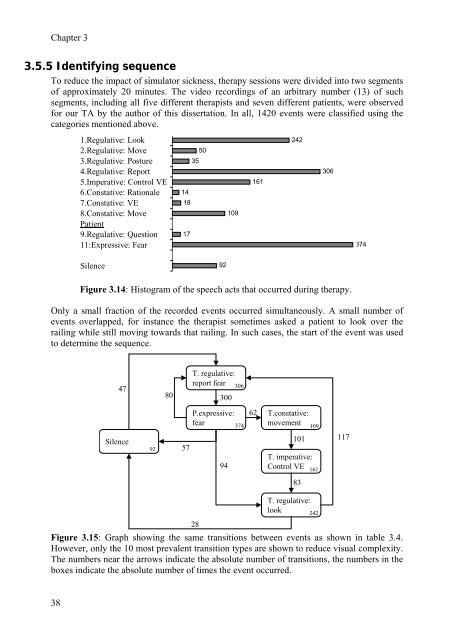Human-Computer Interaction and Presence in Virtual Reality
Human-Computer Interaction and Presence in Virtual Reality
Human-Computer Interaction and Presence in Virtual Reality
You also want an ePaper? Increase the reach of your titles
YUMPU automatically turns print PDFs into web optimized ePapers that Google loves.
Chapter 3<br />
3.5.5 Identify<strong>in</strong>g sequence<br />
To reduce the impact of simulator sickness, therapy sessions were divided <strong>in</strong>to two segments<br />
of approximately 20 m<strong>in</strong>utes. The video record<strong>in</strong>gs of an arbitrary number (13) of such<br />
segments, <strong>in</strong>clud<strong>in</strong>g all five different therapists <strong>and</strong> seven different patients, were observed<br />
for our TA by the author of this dissertation. In all, 1420 events were classified us<strong>in</strong>g the<br />
categories mentioned above.<br />
1.Regulative: Look 242<br />
2.Regulative: Move 50 50<br />
3.Regulative: Posture 35 35<br />
4.Regulative: Report 306<br />
5.Imperative: Control VE 161<br />
6.Constative: Rationale 14 14<br />
7.Constative: VE 18 18<br />
8.Constative: Move<br />
Patient<br />
109<br />
9.Regulative: Question 17 17<br />
11:Expressive: Fear 374<br />
Silence 92<br />
Figure 3.14: Histogram of the speech acts that occurred dur<strong>in</strong>g therapy.<br />
92<br />
Only a small fraction of the recorded events occurred simultaneously. A small number of<br />
events overlapped, for <strong>in</strong>stance the therapist sometimes asked a patient to look over the<br />
rail<strong>in</strong>g while still mov<strong>in</strong>g towards that rail<strong>in</strong>g. In such cases, the start of the event was used<br />
to determ<strong>in</strong>e the sequence.<br />
47<br />
Silence<br />
92<br />
80<br />
57<br />
109<br />
T. regulative:<br />
report fear<br />
P.expressive:<br />
fear<br />
28<br />
300<br />
94<br />
306<br />
161<br />
62<br />
242<br />
T.constative:<br />
movement<br />
374 109<br />
101<br />
T. imperative:<br />
Control VE<br />
83<br />
T. regulative:<br />
look<br />
Figure 3.15: Graph show<strong>in</strong>g the same transitions between events as shown <strong>in</strong> table 3.4.<br />
However, only the 10 most prevalent transition types are shown to reduce visual complexity.<br />
The numbers near the arrows <strong>in</strong>dicate the absolute number of transitions, the numbers <strong>in</strong> the<br />
boxes <strong>in</strong>dicate the absolute number of times the event occurred.<br />
38<br />
161<br />
242<br />
306<br />
117<br />
374
















